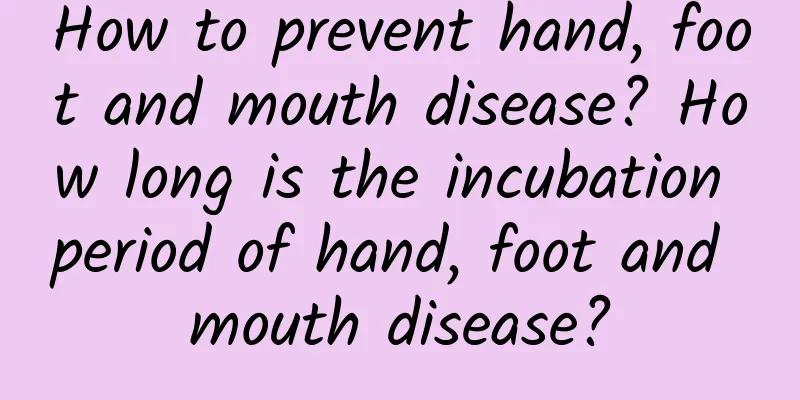How to prevent hand, foot and mouth disease? How long is the incubation period of hand, foot and mouth disease?

|
Hand, foot and mouth disease is an infectious disease caused by enterovirus. There are more than 20 types of enterovirus that can cause hand, foot and mouth disease, among which Coxsackievirus A16 and enterovirus 71 are the most common. So, how to prevent hand, foot and mouth disease? Let's learn about it together with the editor! 1. How to prevent hand, foot and mouth disease 2. Incubation period of hand, foot and mouth disease 3. Transmission routes of hand, foot and mouth disease How to prevent hand, foot and mouth disease Develop good hygiene and eating habits for children: Wash your children's hands with soap and hand sanitizer before meals, after defecation, and after going out. Do not let children drink raw water, eat raw or cold food, or eat leftovers. Let children rest well and get some sun to enhance their immunity. Home hygiene: Pay attention to maintaining a clean home environment, ventilate the room frequently, wash and dry all clothes and bedding frequently, especially those of children. Nursery schools and primary schools: Keep classrooms and dormitories well ventilated. Immediately disinfect toys, bedding, tables and chairs, and also disinfect canteens, toilets, classrooms, etc. Hand, foot and mouth disease incubation period The incubation period of hand, foot and mouth disease is generally 3-6 days. At the beginning of the disease, there are symptoms similar to colds, such as fever, cough, runny nose, nausea, vomiting, etc. The fever can last for 4-5 days. Among other symptoms, the initial symptoms are corn-like maculopapules or blisters with redness around them. Generally, there is no pain or itching, and no trace is left after recovery. In addition, there will be painful ulcers in the mouth, which will cause difficulty in swallowing and loss of appetite. Flat or convex maculopapules or herpes appear on the hands, feet and other parts. The rash is not itchy. The maculopapules turn from red to dark in about 5 days and then disappear. How hand, foot and mouth disease is transmitted Mode of transmission: mainly through close contact between people, and can be indirectly transmitted through hands, towels, cups, toys, tableware, bedding, etc. contaminated by saliva, herpes fluid, feces, etc. The virus in the patient's throat secretions and saliva can be transmitted through droplets. If you come into contact with water contaminated by the virus, you can also be infected through water. Susceptible population: Patients with hand, foot and mouth disease are mainly preschool children, especially those under 3 years old, with the highest incidence rate. |
<<: Early symptoms of hand, foot and mouth disease Early symptoms of hand, foot and mouth disease
Recommend
What is the cause of high jaundice in newborns?
What causes high jaundice in newborns? Hyperbilir...
What is the reason for the white spots on the baby's face? Beware of 3 skin diseases when white spots appear on the baby's face
When parents find small white spots on their chil...
How to treat children's cough? What are the causes of children's cough?
Cough in children is a very common disease. The t...
How long does it take to test for ADHD in children?
The ADHD examination for children usually takes 1...
What are the drugs for treating ADHD?
According to previous domestic surveys, the incid...
Typical symptoms of convulsions in children
Convulsions in children often manifest as sudden ...
Is high exchange transfusion dangerous for neonatal jaundice?
Neonatal jaundice usually refers to high levels o...
Learn more about pediatric pneumonia
The severity of pneumonia in children can vary gr...
What is the radical cure for acute laryngitis in children?
Acute laryngitis in children often has an acute o...
What are the precautions for acute laryngitis in children?
What are the precautions for acute laryngitis in ...
Side effects of ADHD medications in children
The side effects of ADHD medication in children c...
How to use medicine for children's cough? What medicine can cure children's cough quickly?
If a child has a cough, there may be various reas...
Diarrhea treatment prescription for children
There are many reasons why babies have diarrhea. ...
How to treat children's cough? Proper diet is helpful in treating children's cough
Children's cough is a common condition when p...
What should not be eaten for pseudo-jaundice?
Pseudo-jaundice refers to carotenemia, and dietar...









